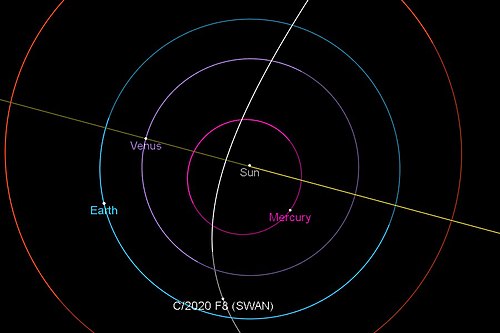Curious about why Comet SWAN vanished before our eyes? Wondering what really happened as it neared the Sun? Welcome, fellow skywatchers and science lovers! At FreeAstroScience.com, we’re here to unravel the mysteries of the cosmos in plain language. Stick with us to the end—by the time you finish reading, you’ll understand not just what happened to Comet SWAN, but why comets sometimes break apart, and what this means for our view of the universe.
What Was Comet SWAN and Why Did It Matter?
Comet SWAN (C/2025 F2) burst onto the astronomical scene in late March 2025, discovered by a trio of amateur astronomers using the SWAN instrument aboard the SOHO spacecraft. The excitement was real: predictions suggested it might become bright enough to see with the naked eye after sunset, a rare treat for anyone who loves stargazing . As it raced toward its closest approach to the Sun—its perihelion—on May 1, astronomers and enthusiasts alike watched with anticipation.
But the universe had other plans. Instead of dazzling us, Comet SWAN’s core didn’t survive the journey. It disintegrated, leaving behind only a faint, fading glow and a trail of questions.
Why Did Comet SWAN Disintegrate Instead of Shining Bright?
Was It the Sun’s Fault?
When comets get close to the Sun, they face intense heat and gravitational forces. Usually, if a comet breaks up at perihelion, we blame the Sun’s tidal forces—those stretching and squeezing effects that can rip a fragile object apart . But here’s the twist: when SWAN broke up, it was still about 200 million kilometers from the Sun. That’s more than the distance from Earth to the Sun! At that range, tidal forces just aren’t strong enough to do the job .
The Real Culprit: A Weak Core and a Sudden Outburst
So what happened? The evidence points to SWAN’s own internal weakness. Comets are often described as “dirty snowballs”—loose collections of ice, dust, and rock. SWAN’s nucleus was probably already fragile, held together by weak cohesion . In early April, it experienced an “outburst”—a sudden, dramatic increase in gas ejection. This outburst likely cracked the core even more, making it vulnerable .
As SWAN drew closer to the Sun, solar radiation ramped up. The already weakened core couldn’t take the stress. It broke apart, and the comet’s brightness plummeted.
How Much Did SWAN’s Brightness Change? (And What Does That Mean?)
Before its breakup, Comet SWAN had an apparent magnitude of 5—just at the edge of naked-eye visibility under dark skies. After the core disintegrated, its brightness dropped to magnitude 8. But what does that really mean?
Let’s break it down:
- The astronomical magnitude scale is a bit counterintuitive: lower numbers mean brighter objects.
- A difference of 3 magnitudes (from 5 to 8) means the comet became about 16 times fainter—a whopping 93.7% decrease in brightness .
Key Takeaway: SWAN didn’t just fade a little—it became almost invisible to all but the most powerful telescopes.
What Did We See? The Beauty Before the Breakup
Even though SWAN didn’t become the naked-eye spectacle we hoped for, it left us with some stunning telescope images. The comet sported a long, elegant tail and a greenish coma—a glowing cloud around its core. That green color? It comes from diatomic carbon molecules, a classic sign of cometary activity .
 Figure: Comet SWAN’s greenish coma and tail, captured before its disintegration.
Figure: Comet SWAN’s greenish coma and tail, captured before its disintegration.
Are Comet Breakups Like SWAN’s Common?
Absolutely. Comet SWAN isn’t alone in its fate. Let’s look at a few recent examples:
| Comet Name | Year | What Happened? |
|---|---|---|
| C/2019 Y4 (ATLAS) | 2020 | Fragmented into dozens of pieces before perihelion, never became visible. |
| C/2024 S1 (ATLAS) | 2024 | Broke apart as it neared the Sun, earning the nickname “Halloween comet.” |
| 332P/Ikeya-Murakami | 2016 | Captured by Hubble breaking into multiple fragments. |
These cases show that cometary breakups are a natural part of their life cycle. Sometimes, it’s the Sun’s gravity. Other times, it’s internal weakness or sudden outbursts. Each event teaches us more about these ancient wanderers from the edge of our solar system .
What Can We Learn from SWAN’s Demise?
Comet SWAN’s story is a powerful reminder: the universe is unpredictable. Even with our best predictions, nature can surprise us. But every comet, even those that break apart, gives us clues about the early solar system. By studying their composition, behavior, and dramatic ends, we get a little closer to understanding where we come from.
Key Finding: The disintegration of Comet SWAN, while disappointing for skywatchers, is a scientific goldmine. It helps us refine our models of comet structure, outbursts, and the effects of solar radiation.
Why Do We Care About Comets Anyway?
Comets are time capsules. They’re leftovers from the formation of the solar system, carrying ancient ices and dust. When they break apart, they reveal their secrets—sometimes in a spectacular show, sometimes in a quiet fade. Either way, they connect us to the cosmic story of our origins.
Conclusion: The Legacy of Comet SWAN
Comet SWAN’s journey was short but meaningful. It promised a show, but instead gave us a lesson in cosmic fragility. We watched as it brightened, then faded, and finally broke apart—reminding us that the universe doesn’t always follow our script.
As we look up at the night sky, let’s remember: every comet, every star, every fleeting glow has a story. Sometimes, the most important lessons come from what we almost saw. At FreeAstroScience.com, we’re here to make sense of these cosmic tales—so you can marvel at the universe with new eyes.
Keep looking up. The next great comet might be just around the corner—and we’ll be here to help you understand it, every step of the way.


Post a Comment